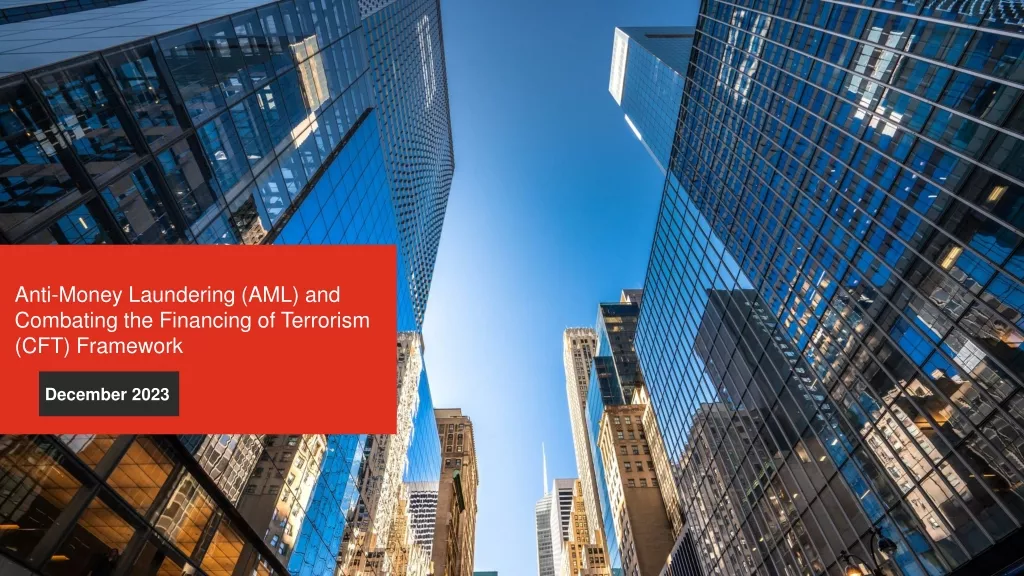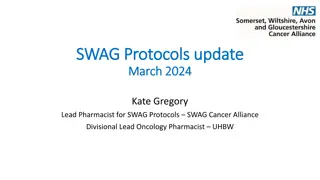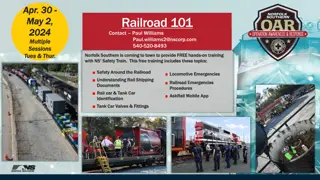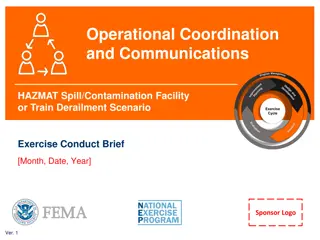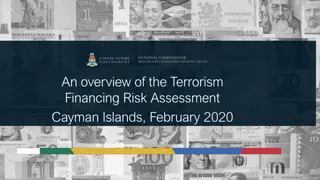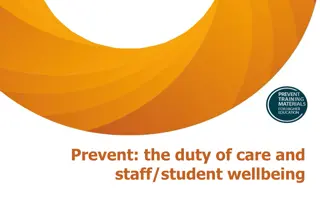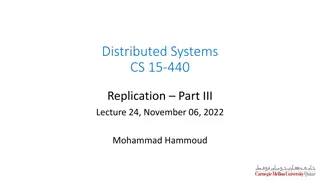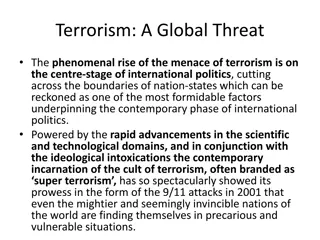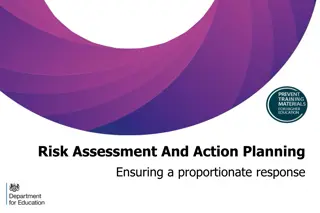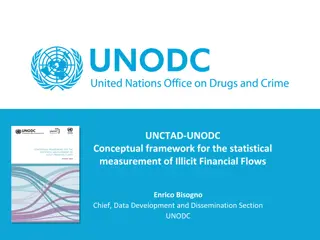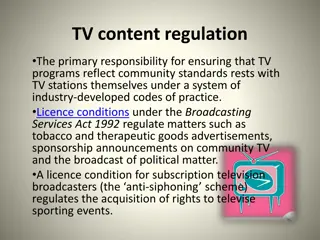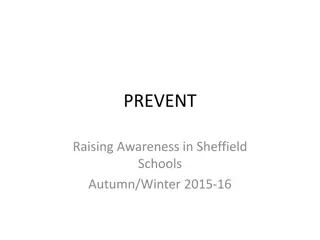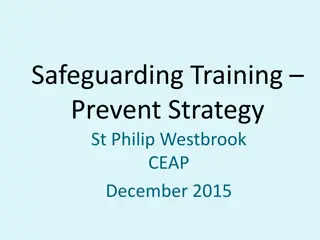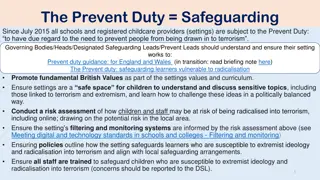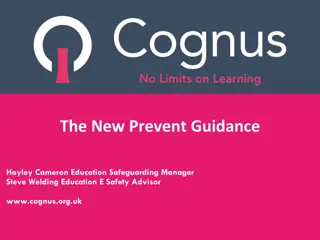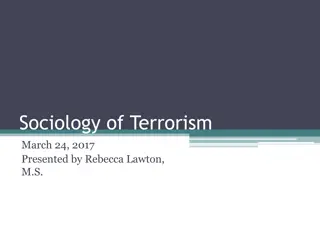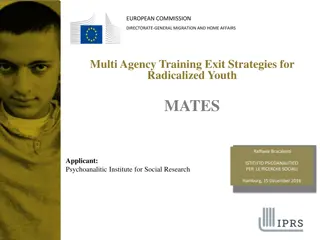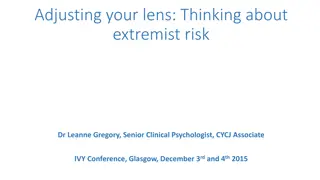HAZMAT and Terrorism Response Protocols
This module covers HAZMAT awareness, safety protocols, and CERT tasks in dealing with hazardous materials incidents. It also provides guidance on recognizing and responding to potential terrorism incidents. Key topics include using the Emergency Response Guidebook, CERT team responsibilities, victim assistance, and actions to take in the event of terrorism warnings. Awareness, preparation, and quick response are emphasized to protect both responders and the community.
Download Presentation

Please find below an Image/Link to download the presentation.
The content on the website is provided AS IS for your information and personal use only. It may not be sold, licensed, or shared on other websites without obtaining consent from the author.If you encounter any issues during the download, it is possible that the publisher has removed the file from their server.
You are allowed to download the files provided on this website for personal or commercial use, subject to the condition that they are used lawfully. All files are the property of their respective owners.
The content on the website is provided AS IS for your information and personal use only. It may not be sold, licensed, or shared on other websites without obtaining consent from the author.
E N D
Presentation Transcript
HAZMAT Advancement Module 03 Dallas CERT
Materials for this unit: You should have a copy of the Emergency Response Guidebook, either in print or online, plus - paper and a pen or pencil The current electronic copy is available at: https://www.phmsa.dot.gov/hazmat/library/erg
HAZMAT Overview CERT safety protocol for hazmat Reading Placards Using the Emergency Response Guide (ERG) Response within CERT abilities
HAZMAT Stats
HAZMAT Texas
HAZMAT CERT Protocol CERT team members must protect themselves and others, doing the greatest good for the greatest number CERT training is not sufficient to: deal directly with a hazardous substance, or rescue people affected by the substance MOVE AWAY and keep others safe
HAZMAT CERT Tasks OBSERVE size up the incident Location, wind direction, people affected Substance involved REPORT EVACUATE & SET UP A PERIMETER DECONTAMINATION consult ERG, use tepid/cold water, blot dry TRIAGE any injuries
HAZMAT CERT Tasks While CERT members should not get close to a hazmat incident, that does not mean they should abandon victims. Verbal support may be possible until professional responders arrive Victims may be talked into moving to a decontamination area The ERG also has suggested first aid cautions for each substance
TERRORISM? If you recognize event as potential terrorism incident Notify OEM or 911 of potential terrorist incident Isolate the scene and deny entry Scan for secondary devices Do not drive through spills or clouds Position vehicles headed away from the incident for a quick departure Look for physical indicators: - Debris field - Casualties - Dead animals and vegetation - Unusual odors, color of smoke, vapor clouds Protect crime scene and evidence
HAZMAT Gear Up CERT Team should wear full Personal Protective Equipment (PPE) to protect against accidental minor exposure, provide very limited protection, and keep out particulates & smoke Nitrile & work gloves Helmet Goggles Work boots or Galoshes (if available)
HAZMAT CERT Tasks CAUTION In any HAZMAT situation involving explosives or terrorist potential DO NOT use radios or cell phones within the evacuation zone and preferrably within at least a half mile These electronic devices may : Cause an static charge to build Activate a radio frequency trigger device
HAZMAT Time, Distance, Shielding Observe ERG evacuation distances
HAZMAT Time, Distance, Shielding Evacuate upwind, uphill, upstream Contamination Reduction zone Support zone Public exclusion zone Perimeter
NFPA 704* Response Guide Numbers * NFPA = National Fire Protection Association
HAZMAT Time, Distance, Shielding Note that in the ERG, some of the explosive substance Guides say: Move people out of the line of sight of the scene and away from windows Does that translate into TAKE COVER for you?
ERG 2012 Size Up Table of Placards Find the early pages of the ERG that depict the different placards used in the transport of dangerous goods. Should the placard on a vehicle be damaged, the general appearance gives a clue about the goods. Each group of placards is associated to a 3-digit guide number (ORANGE Section). Caution: The recommended guides should be considered as a last resort if the material cannot be identified by any other means.
ERG 2012 Size Up Rail Car and Road Trailer ID Charts Find the pages that depict the general shapes of railcars and road trailers used in the transportation of dangerous goods. Their shape is another clue. Each shape is associated to a 3-digit guide number in the ORANGE Section (Table 1 is the GREEN section) Caution: The recommended guides should be considered as a last resort if the material cannot be identified by any other means.
ERG2016 A) The 4-digit ID Number on a placard or orange panel;
ERG2012 B) The 4-digit ID Number (following UN or NA) on a shipping document or package; Example of a shipping document
ERG2016 C) The name of the material on a shipping document or package. Example of a package Example of a shipping document
ERG 2016 1) Look up the material s 3-digit Guide number in either: The ID Number index (YELLOW-bordered pages); The name of material index (BLUE-bordered pages); Note if the substance is highlighted in GREEN. As a last resort, if the ID number or the name of material are not available, use the Table of Placards and/or the Rail Car & Road Trailer Identification Charts
ERG 2016 2) Turn to the numbered guide (ORANGE- bordered pages): Read carefully all the information provided in the ORANGE Guide; use jointly the GREEN Section if the substance is highlighted green in the yellow or blue section
ERG 2016 CAUTION:If a reference to a guide cannot be found and the incident is believed to involve dangerous goods: Turn to GUIDE 111 and use it until additional information becomes available. If the incident involves explosives: Use GUIDE 112 for all explosives, except: For Class 1.4 Explosives, use GUIDE 114. (Class 1.4 has no significant blast hazard)
Now for some Examples! For each of the following examples: Find the ORANGE-bordered Guide-pages using the information provided; Identify the suggested distances / zones in the ORANGE and/or GREEN Sections; Describe the main characteristics and hazards of the substance.
Example 1 A 1000-litre tote container is leaking. 1824
Solution for Example 1 ID No. is 1824 1824 The YELLOW-bordered pages indicate that the name of the material is Sodium hydroxide, solution or Caustic soda, solution and refers to Guide 154; Substance not highlighted; no need for the GREEN Section; The Guide 154 corresponds to Substances - Toxic and/or Corrosive (Non-Combustible); As an immediate measure, the Guide suggests to isolate the leak area in all directions for at least 50 metres for liquids
Solution for Example 1 In Guide 154, under the Potential Hazards Section, the Health hazards precede the Fire or Explosion hazards; This type of substance is toxic by inhalation / ingestion / skin contact and may cause severe injury or death; Effect of contact or inhalation may be delayed; Fire may produce irritating, corrosive and/or toxic gases; This type of substance is non-combustible. 1824
Example 2 A tanker truck carrying the following product rolled over and is leaking from the top hatch.
Solution for Example 2 ID No. is 1202 The YELLOW-bordered pages indicate that the substance is Dieselfuel or Fuel oil, and refers to Guide 128; Substance not highlighted; no need for the GREEN Section The Guide 128 corresponds to Flammable Liquids (Non- Polar / Water-Immiscible); As an immediate precautionary measure, the Guide suggests to isolate spill or leak area for at least 50 metres in all directions. If the spill is large, the Guide suggests to consider an initial downwind evacuation of at least 300 metres;
Solution for Example 2 At Guide 128, under the Potential Hazards Section, the Fire or Explosion hazards precede the Health hazards; This type of substance is flammable and vapours may form explosive mixture with air; Most vapours are heavier than air, they will spread along the ground and collect in low or confined areas; Containers may explode when heated; Inhalation or contact with material may irritate or burn skin and eyes.
Example 3 A truck displaying this placard is on fire on the side of the road.
Solution for Example 3 The placard indicates the material is an explosive of class 1.4G; According to the Table of placards, Guide 114 must be used when explosives in class 1.4 are involved; Explosives are not highlighted; there is no need to refer to the GREEN Section (see Explosives in the BLUE Section); In case the truck is involved in a fire, the Guide suggests to isolate for 500 metres in all directions and to initiate an evacuation, including emergency responders, for 500 metres in all directions;
Solution for Example 3 At Guide 114, under the Potential Hazards Section, the Fire or Explosion hazards precede the Health hazards; This type of substance may explode and throw fragments at a distance of 500 metres or more if fire reaches cargo; Fire may produce irritating, corrosive and/or toxic gases.
Example 4 A tanker truck is involved in a road accident.
Solution for Example 4 The ID No. is 1072; The YELLOW-bordered pages indicate that the product is Oxygen, compressed and refers to Guide 122; Substance not highlighted; no need for the GREEN Section The Guide 122 corresponds to Gases - Oxidizing (Including Refrigerated Liquids); As an immediate precautionary measure, the Guide suggests to isolate spill or leak area for at least 100 metres in all directions; In case of a large spill, the Guide suggests to consider an initial downwind evacuation of at least 500 metres;
Solution for Example 4 At Guide 122, under the Potential Hazards Section, the Fire or Explosion hazards precede the Health hazards; This type of substance does not burn, but will support combustion; Some may react explosively with fuels; Containers may explode when heated; Vapours may cause dizziness or asphyxiation without warning.
Solution for Example 5 There is no ID No. and the DANGER placard indicates a mixed load of dangerous goods; In this case, refer to Guide 111, Mixed Load / Unidentified Cargo; As an immediate precautionary measure, the Guide suggests to isolate the area for at least 100 metres in all directions, until the contents of the vehicle is known; In case of fire, the Guide suggests to isolate for 800 metres in all directions and to consider an initial evacuation of 800 metres in all directions;
Solution for Example 5 At Guide 111, under the Potential Hazards Section, the Fire or Explosion hazards precede the Health hazards; Until the vehicle content is known, all hazards must be considered: flammability, corrosivity, toxicity
Example 6 A rail car is leaking at a well-known facility in your area, where chlorine cars are handled. KTVI-TV St.Louis, Missouri, USA
Solution for Example 6 KTVI-TV St.Louis, Missouri, USA The product involved is Chlorine; The BLUE-bordered pages indicate that the ID number is 1017, refers to Guide 124 and the substance is highlighted; The Guide 124 corresponds to Gases Toxic and/or Corrosive Oxidizing; Because the substance is highlighted and there is a spill situation, the Initial Isolation and Protective Action Distances must be taken from the GREEN Section; For ID 1017, the GREEN Section suggests refers to Table 3 which says for large spills use 500 metres as an Initial Isolation Distance;
Solution for Example 6 KTVI-TV St.Louis, Missouri, USA For ID 1017, the GREEN Section suggests, for large spills during the day, 2.1 miles as a Protective Action Distance in moderate wind; The Emergency Responders will have to decide which Protective Action will be pursued: evacuation, shelter in place, or a combination of both; At Guide 124, under Potential Hazards, the Health hazards precede the Fire or Explosion hazards; The Guide 124 indicates that this product is toxic and may be fatal if inhaled or absorbed through the skin.
Example 7 A drum is leaking in a puddle of water. 1689
Solution for Example 7 The ID Number is 1689; The YELLOW-bordered pages indicate that this substance is Sodium cyanide; It refers to Guide 157 and the substance is highlighted; The Guide 157 corresponds to Substances Toxic and/or Corrosive (Non-Combustible / Water-Sensitive); The substance is highlighted and there is a spill situation: Table 1 / the GREEN Section must be used to determine the Initial Isolation and Protective Action Distances; 1689
Solution for Example 7 Under ID No.1689, the GREEN Section suggests distances specifically when the product is spilled in water. If this is not the case, the initial isolation and evacuation distances must be taken from Guide 157, under Public Safety; Since the product is leaking in water, the GREEN Section suggests an Initial Isolation Distance of 30 metres in all directions for a small spill and 100 metres in all directions for a large spill; Additionally, the Protective Action Distances for day and night will have to be taken from the GREEN Section; 1689
Solution for Example 7 The Guide 157 indicates that this type of substance is toxic and non-combustible, but fire will produce irritating, corrosive and/or toxic gases; For a water-reactive substance (mention when spilled in water in Table 1), refer to the last pages of the GREEN Section (Table 2), where the TIH gases produced are listed, for each water-reactive substance; in this case the gas produced is HCN or Hydrogen cyanide; Searching for Hydrogen cyanide in the BLUE Section, there is a reference to Guide 117, which correspond to Gases Toxic Flammable (Extreme Hazard). 1689
Solution for Example 7 NOTE: In the GREEN section (Table 1), you must use the Initial Isolation and Protective Action Distances (IIPAD) for the water reactive material itself (when spilled in water) (in this case UN1689)and not the IIPAD for the generated TIH gas (Hydrogen cyanide). Be prepared to move back though! 1689
Example 8 A drum containing this substance is punctured and is leaking on the ground. 2692


